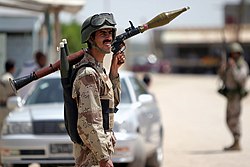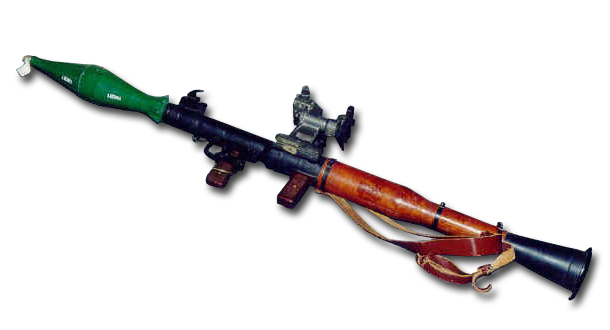 particularly significant asset on the modern asymmetric battlefield. The role of the man-portable anti-armor weapon continues to morph from a dedicated anti-tank weapon to a general-purpose fire support asset for light and medium forces. (Photo: Iraqi Security Force (ISF) soldier with an RPG 7)
particularly significant asset on the modern asymmetric battlefield. The role of the man-portable anti-armor weapon continues to morph from a dedicated anti-tank weapon to a general-purpose fire support asset for light and medium forces. (Photo: Iraqi Security Force (ISF) soldier with an RPG 7)
In its annual analysis, "The Market for Man-Portable Anti-Armor and ‘Bunker Buster’ Weapons," the Forecast International Weapons Group expects the market will produce over 1.79 million weapons, worth in excess of $5 billion, through 2018.
According to Dean Lockwood, a weapons systems analyst at Forecast International, “The market is evolving to address radical changes in the worldwide security environment. The challenges of this new environment present particularly ripe opportunities for man-portable anti-armor and bunker buster weapons.” Russian defense contractors will continue to dominate the market, accounting for 59.31 percent of man-portable anti-armor and bunker buster weapon production, worth 46.53 percent of the total market value, through 2018.
During this period, the RPG-26 and RPG-27 will account for 44.63 percent of all new production, worth 25.55 percent of the total market value. Nevertheless, the ubiquitous RPG-7 remains the man-portable anti-armor weapon of choice worldwide.
The Forecast International Weapons Group expects the Russian RPG-7 series, as well as various licensed and unlicensed copies, will account for 7.55 percent of all new production, worth 5.37 percent of the total market value, through 2018. In contrast, the combined output of the leading European players will provide 12.10 percent of all man-portable anti-armor and bunker buster weapons production.
However, these European players will account for 28.94 percent of the total market value through 2018. Of the European programs, Lockwood expects the MBT LAW will prove the most significant, accounting for 4.18 percent of all production, worth 16.15 percent of the total market value, through 2018.
Talley Defense Systems remains the sole American player to have an impact on the international market for man-portable anti-armor and bunker buster weapons. Talley’s line of M72 LAW and M141 Bunker Defeat Munitions will account for 19.38 percent of all production, worth 16.78 percent of the total market value, through 2018. Unusually, the People’s Republic of China has virtually no impact on this market, contributing only 1.14 percent of total production and 0.70 percent of total market value with its Type 69 line. 
The RPG-7 is a widely-produced, portable, shoulder-launched, anti-tank rocket propelled grenade weapon. Originally the RPG-7 [Hand-held], Protivotankovyi [Anti-Tank], Granatomjët and its predecessor, the RPG-2, were designed by the Soviet Union, and now manufactured by the Bazalt company. The weapon has the GRAU index 6G3. The ruggedness, simplicity, low cost, and effectiveness of the RPG-7 have made it the most widely used anti-tank weapon in the world. Currently around 40 countries use the weapon, and it is manufactured in a number of variants by nine countries. It is also popular with irregular and guerrilla forces. The RPG has been used in almost all conflicts across all continents since the mid-1960s from the Vietnam War to the present day War in Afghanistan and Iraq War. The most commonly seen major variations are the RPG-7D paratrooper model (able to be broken into two parts for easier carrying), and the lighter Chinese Type 69 RPG. The RPG-7 was first delivered to the Soviet Army in 1961 and deployed at a squad level. It replaced the RPG-2, having clearly out-performed the intermediate RPG-4 design during testing. Its original design concept originated with two World War II era weapons: the American Bazooka and the German Panzerfaust. The current model produced by Russia is the RPG-7V2, capable of firing standard and dual high explosive anti-tank (HEAT) rounds, high explosive/fragmentation, and thermobaric warheads, with a UP-7V sighting device fitted (used in tandem with the standard 2.7x PGO-7 optical sight) to allow the use of extended range ammunition. The RPG-7D3 is the equivalent paratrooper model. Both the RPG-7V2 and RPG-7D3 were adopted by the Russian Ground Forces in 2001.

Despite the uncertainties of a post-Cold War world and the glut of available weapons, the international market for man-portable anti-armor and bunker buster weapons remains a vibrant, dynamic environment. Evolving threat scenarios and new force structures are creating a new field of opportunity for the man-portable anti-armor weapon on the modern asymmetric battlefield.
Forecast International, Inc. is a leading provider of Market Intelligence and Analysis in the areas of aerospace, defense, power systems and military electronics. Based in Newtown, Conn., USA, Forecast International specializes in long-range industry forecasts and market assessments used by strategic planners, marketing professionals, military organizations, and governments worldwide.


















No comments:
Post a Comment